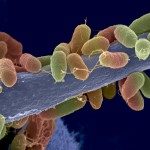Lien vers Pubmed [PMID] – 9150209
J. Bacteriol. 1997 May;179(10):3154-63
Two exo-beta-1,3-glucanases (herein designated exoG-I and exoG-II) were isolated from the cell wall autolysate of the filamentous fungus Aspergillus fumigatus and purified by ion-exchange, hydrophobic-interaction, and gel filtration chromatographies. Molecular masses estimated by sodium dodecyl sulfate-polyacrylamide gel electrophoresis and gel filtration chromatography were 82 kDa for the monomeric exoG-I and 230 kDa for the dimeric exoG-II. exoG-I and exoG-II were glycosylated, and N glycans accounted, respectively, for 2 and 44 kDa. Their pH optimum is 5.0. Their optimum temperatures are 55 degrees C for exoG-I and 65 degrees C for exoG-II. By a sensitive colorimetric method and high-performance anion-exchange chromatography for product analysis, two patterns of exo-beta-1,3-glucanase activities were found. The 230-kDa exoG-II enzyme acts on p-nitrophenyl-beta-D-glucoside, beta-1,6-glucan, and beta-1,3-glucan. This activity, which retains the anomeric configuration of glucose released, presented a multichain pattern of attack of the glucan chains and a decrease in the maximum initial velocity (Vm) with the increasing size of the substrate. In contrast, the 82-kDa exoG-I, which inverts the anomeric configuration of the glucose released, hydrolyzed exclusively the beta-1,3-glucan chain with a minimal substrate size of 4 glucose residues. This enzyme presented a repetitive-attack pattern, characterized by an increase in Vm with an increase in substrate size and by a degradation of the glucan chain until it reached laminaritetraose, the limit substrate size. The 82-kDa exoG-I and 230-kDa exoG-II enzymes correspond to a beta-1,3-glucan-glucohydrolase (EC 3.2.1.58) and to a beta-D-glucoside-glucohydrolase (EC 3.2.1.21), respectively. The occurrence and functions of these two classes of exo-beta-1,3-glucanases in other fungal species are discussed.



